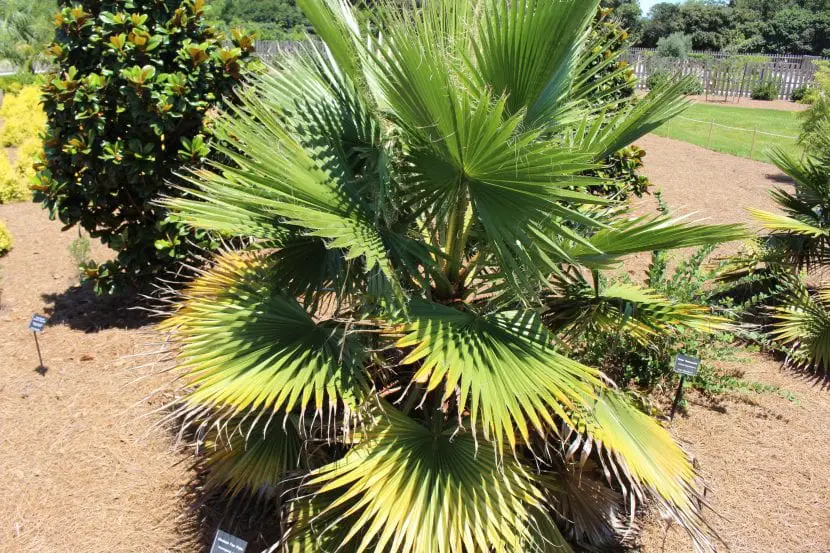
The Robust Washingtonia it is one of the most common palm trees in the temperate and warm regions of the world. It grows very quickly, to the point that if the conditions are suitable it can reach one meter in height in its first year of life. In addition, the seeds germinate with extraordinary ease and, if that were not enough, it is reasonably well resistant to drought.
So why not have one at home? It has it all, well, almost. Its fruits are not edible, but … its maintenance is so simple that you would almost say that you see movement from one day to the next. Find out all about the Robust Washingtonia.
Origin and characteristics of Washingtonia robusta

The Mexican fan palm, Mexican palm or Wachintonia, whose scientific name is Robust Washingtoniais a plant native to the south of the Baja California peninsula, in Mexico. It reaches a height of up to 35 meters, with a slender and simple trunk with a diameter not exceeding 35-40 centimeters. Its leaves are costapalmate, that is, they are fan-shaped, with some white threads. The petioles are long and armed with thick spines.
The flowers are grouped in axillary inflorescences. They are highly branched and hanging. The fruit has a spherical shape, is black in color and measures about 0,5cm in diameter..
How do you take care of yourself?

If you have just purchased a copy, do not hesitate to provide the following care:
Location
The Robust Washingtonia it is a palm tree that It must be located outside, in full sun. Due to its characteristics, it is best to plant it in the ground as soon as it is about 30cm high, since in a pot it has trouble looking pretty.
Irrigation
As long as it is in a pot and during the first year it is in the ground, it must be watered often: 2-3 times a week in summer and every 5-6 days the rest of the year. From the second year of planting we will not have to water.
Subscriber
Not very necessarybut it can be paid from the beginning of spring to the end of summer with specific fertilizers for palm trees. We can also add egg and banana peels, vegetables that are no longer edible, herbivorous animal manure o bat guano.
Planting or transplanting time
The best time to plant it in the garden it’s in springwhen the risk of frost has passed.
Multiplication
The Robust Washingtonia it multiplies only by seeds in spring or summer. The step by step to follow is the following:
- The first thing to do is put the seeds in a glass of water for 24 hours. The next day we will discard those that have remained floating, as they will not germinate.
- Then, we fill a seedbed (pots, milk containers, glasses of yogurt, …) with universal culture substrate mixed with 30% perlite.
- Next, we water and place the seeds in the seedbed so that they are a little bit buried. It is important not to put many in the same container, since it is most likely that they will all germinate and, as a consequence, we will have problems later to separate them. It is best not to put more than 2 in a 10,5cm diameter pot.
- Finally, we will water again and place the seedbed outside, in full sun.
The first seedlings will come out soon, after 1-2 weeks, but we will have to keep them in their pots until they have at least two leaves.
Plagues and diseases
In general, they are very resistant plants, but especially in recent times their population is decreasing a lot due to insects, which are:
- Red weevil: its scientific name is Rhynchophorus ferrugineus. It is a weevil (it is similar to a beetle, only thinner) whose larvae excavate galleries in the heart of the palm tree. In doing so, from the outside what we see is the deviation of the central sheet. Perforations are also sometimes seen in the trunk, but what is most striking are the amount of fibers that the insect can remove from the interior of the plant.
The most effective treatment so far is preventive. Chlorpyrifos 48% insecticide applied during all warm months is the only really useful life saver out there. However, there are other home remedies that could work, which are those described in this article. - he is the archon: it is a moth that is very reminiscent of a butterfly whose larvae cause many problems for the palm tree. The symptoms it causes are similar to those of the weevil: weakening of the plant, arching of the eye (guide-leaf), perforations in the trunk, and also holes in the leaves that form a fan when they open.
The treatment is the same as in the previous case.
If we talk about diseases, overwatering or not using disinfected pruning tools could be affected by Phytophthora or pink fungus (Nalanthamala vermoesenii). In both cases, the leaves appear apparently fine, but if you pull them it is easy to remove them since the trunk or stem is rotten. To prevent them, you have to control the risks and disinfect the tools before and after using them.
Pruning
Dry leaves can be removed in autumn. I do not advise doing it in spring, much less in summer due to the high risk of the plant being attacked by weevil or paysandisia. If you live in an area with a mild or warm climate, you have to wait for the temperatures to drop and remember to seal the wound with healing paste.
Rusticity
Resists cold and frost up to -7ºC.

What did you think of Robust Washingtonia? Pretty, right?
